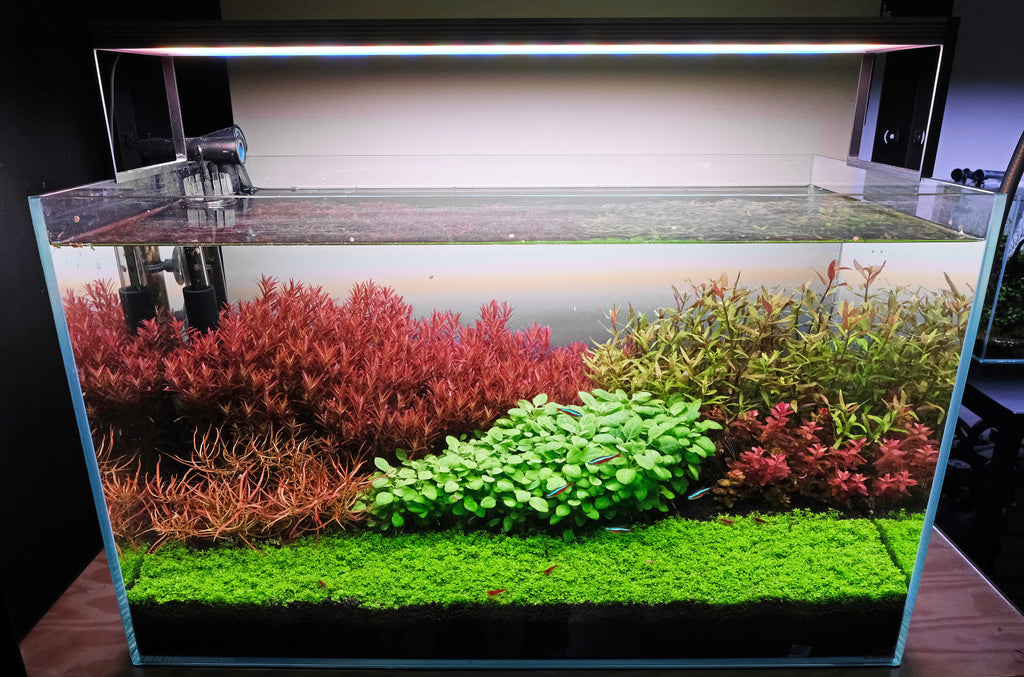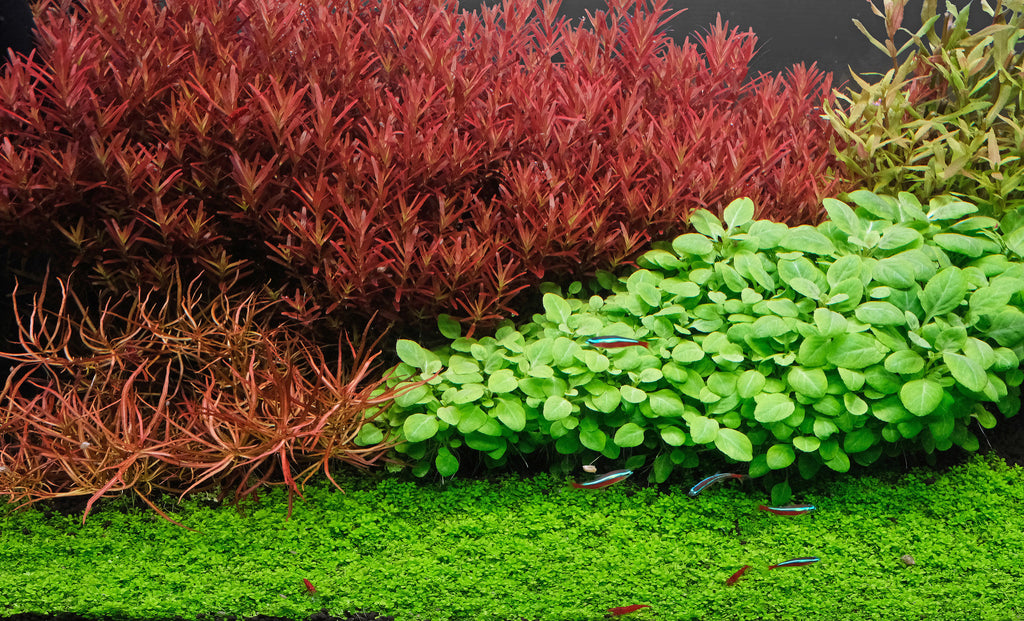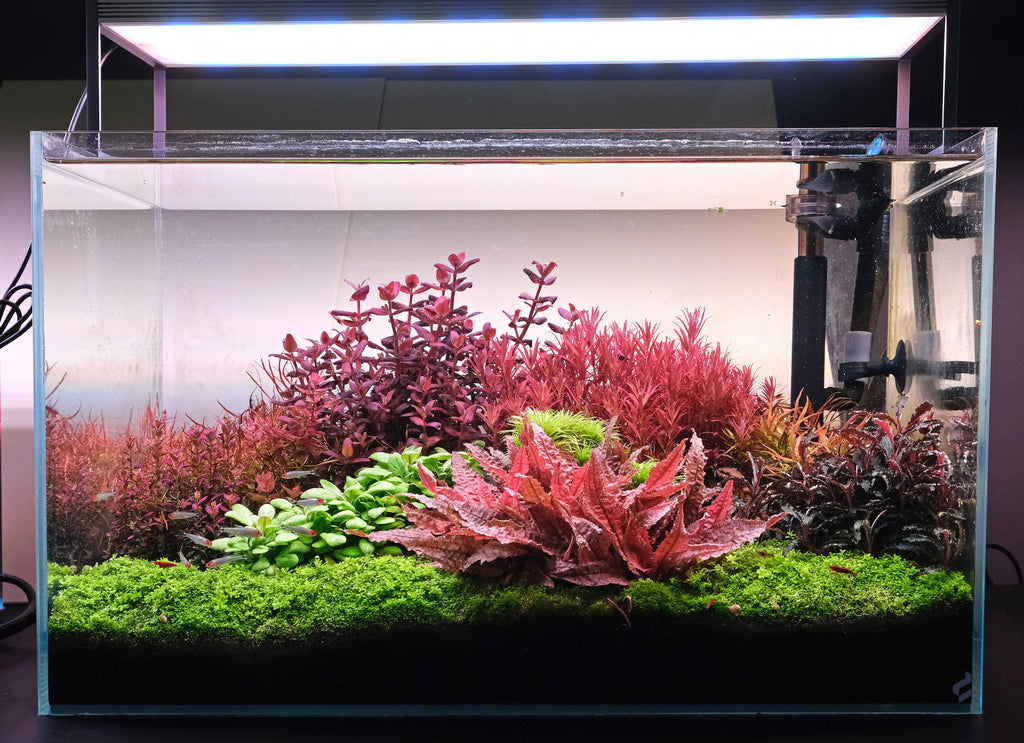

The above picture is taken after the 1st week of a fresh setup, diatoms are just starting to form and many of the leaves have a large amount of algae on them. The same tank is below, after a month, with no use of algicide and using the exact same plants as above; no new plants were added. There were no parameter changes as well – so what was done ?
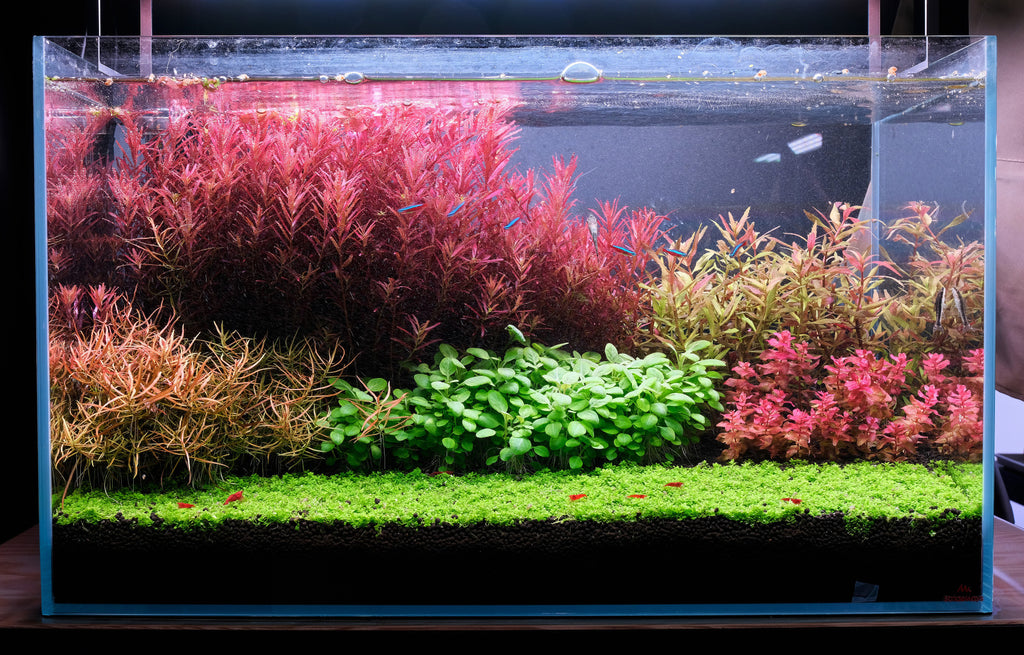
The first few weeks are the toughest
A planted aquarium goes through many changes in the first few weeks of a fresh setup, especially if the tank was not cycled before hand. Large, but invisible changes occur in the tank upon submergence. The tank’s microbial community need time to mature; most hobbyists are familiar with ammonia cycling and how long it takes. Just as the filter takes time to develop a microbial community, the substrate’s ecology needs to convert from dry form to submerged form; with a different population of microbial life adapted to underwater soils. These microbes perform important functions such as breaking down organic waste, and oxidising harmful compounds such as ammonia. Larger sized microbes are also responsible for consuming algae. Read more on algae and tank maturity here.
Freshly planted plants will go through a period of adaptation stress, as they reprogram their proteins and enzymes to make best use of the resources in their new environment. Some of these changes are obvious, such as emersed grown plants adapting to submerged conditions by growing underwater form leaves that look markedly different from their emersed leaves. Other changes are less visible – such optimizing RuBisCO; an enzyme involved in the first major step of carbon fixation, to match the new environment’s Carbon dioxide levels. Plant immune systems are weakened during this period due to the transition stress, and algae opportunistically bloom and attach to the plants, feeding off metabolites that leak from the leaf margins. Often we find our freshly planted tanks becoming algae filled messes within a couple of weeks.
Diatoms are most common, along with hair/fuzz algae or even Staghorn and BGA. Algae invasions can happen in days in high light tanks. In tanks with more moderate light levels, they usually appear in the second week or so.
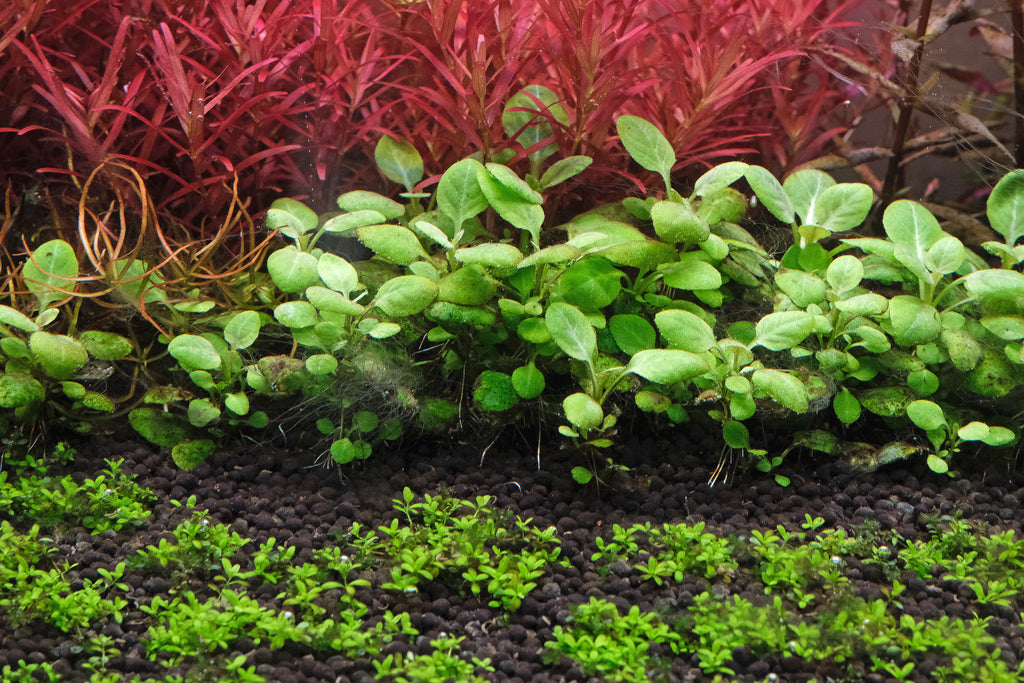
Closeups of the tank from top in the second week. A mix of staghorn, green spot algae and diatoms invade the tank.
However, if we look closely, there is a lot of fresh growth that is relatively algae free, while it is old growth that is heavily affected by algae. This is an important observation; algae does not affect all areas of the tank – it attacks mostly older growth on plants while leaving the new fresh leaves relatively untouched. Why?
Plants that are growing robustly produce an array of anti-microbial chemicals; various alkaloids, terpenes, phenolics, as a defence against pathogens and microbes. Plants will prioritize defending the valuable new leaves first, as these newest leaves are optimized and adapted to the current environment and contribute the most. Leaves have limited plasticity, so older leaves have limited ability to be adapted to new environments. Parallel to this, the plant may draw reserve energy and nutrients from older leaves to fund the growth of new leaves. The bigger the change in environment, the more we see this in play. As the plant abandon defending the older leaves, metabolites leak from the leaf margins and attract algae to spawn.
While the exact mechanism of plant defences and algae triggers can be complicated, the useful observation is this: Old or unhealthy leaves attract algae, while robustly grown, fresh new leaves are algae resistant. While hobbyists have been obsessed with correlating particular nutrients or parameters with algae growth, the far more common trigger for algae in most tanks is unhealthy/old leaves which plants have given up defending. Plants sacrifice old growth when they are under adaptation stress or not getting their needs fulfilled.
This is the reason why in the 2hr Way, we always state that healthy plants are the best defence against algae.
What not to do!
Faced with a sudden onslaught of algae, most hobbyists immediate urge is to make drastic changes to tank parameters, thinking that the algae was caused by too much of or a lack of nutrients or CO2 or some other parameter. This is the worst course of action. When plants are trying to adapt to the new environment, changing the environment constantly is a recipe for disaster. Plants need time and a stable environment to grow well. When plants fail to keep up with environmental changes, they will be constantly vulnerable to algae.
What you should have done but did not
Cycling the tank, soil in and with filter on, but without plants or lights on, for a week+ to allow the tank to mature somewhat can help avoid some algae issues and ease plant transition stress. Adding some old soil during the setup or using established filter media can also help faster microbial growth.
Starting the tank with moderate light < 100 umols of PAR at substrate also leads to less algae triggering. For folks intending to run very high light systems; you can always tune it up after the plants have grown in.
The key is to have good parameters from the start so that drastic changes need not take place after plants are added – having a good level of CO2 and a solid fertilization regime – then keeping parameters constant as the tank matures. These two critical aspects should be planned and tuned before hand, not tweaked after plants have been added.
Tune CO2 levels before adding plants. Many folks still under estimate the impact that CO2 has. Plants use more Carbon than all the other nutrients combined. Having good CO2 levels is the best thing a tank can do for easing the transition stress of aquatic plants. It is the key to getting difficult species to survive. Avoid using drop checkers, they are inaccurate and lag terribly. Learn to use the 1 pH drop method to estimate CO2 levels.
For the tank above, no changes were made in terms of dosing or CO2 injection levels or any other measurable parameter. No algicides were used either. Diatoms reproduces very quickly in new setups; algicides are not particularly effective against them if the root causes are not solved.
Steps to take, now that algae has invaded
As the plants adapt to the environment, new growth should be in good shape and relatively algae free, with algae affecting mostly older leaves. We will aim to remove the worst of the old growth, while giving space for the new leaves to grow. This will be done through a combination of trimming and uprooting and replanting of tops. Additionally, any organic detritus collecting on the substrate surface should be siphoned off during water changes.
Trimming off older leaves
When plants produce leaves, the new leaf will be programmed to suit the current environmental conditions. Leaves have limited plasticity and ability to adapt once they are matured. Thus if tank conditions change or if the plant is transplanted to a new environment, the plant has to produce new leaves that are adapted to the new environment. Old leaves may be abandoned if they no longer contribute much (especially if the new environment is markedly different from the previous) and these leaves become a prime target for algae.
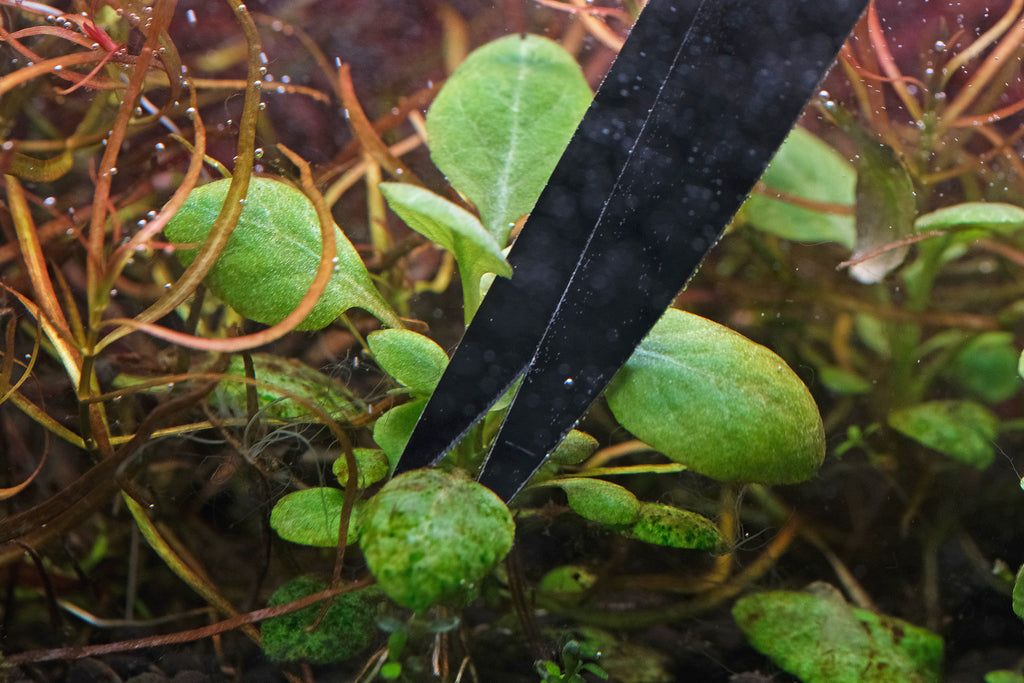
Cutting off these older leaves allow new leaves to develop and take their space. It removes a potential home for algae, while making space for new growth. How do we determine whether older leaves should be removed? Being badly affected by algae is a great signal that plants have abandon devoting resources to maintaining that particular leaf. Aim to remove leaves that are very badly covered with algae or damaged with holes.
Replanting tops, discarding bottoms
For faster growing stem plants, we have the option of discarding the entire portion of the older stem, and replanting the fresh top portion. This requires us to uproot the entire stem plant, and replanting only the top 3 inches or so. We can vary the length to replant depending on how much of the stem/leaves is in good form and also what height we want a particular bush to start at. Stem plants can grow from as little as an inch for smaller species, to 3 – 5 inches or so for larger species. This action fills the tank with algae resistant new growth, while simultaneously removing old growth that attracts algae. The baseline condition is that your growth parameters must be in place, for the plants to have produced robust new leaves that you can replant.
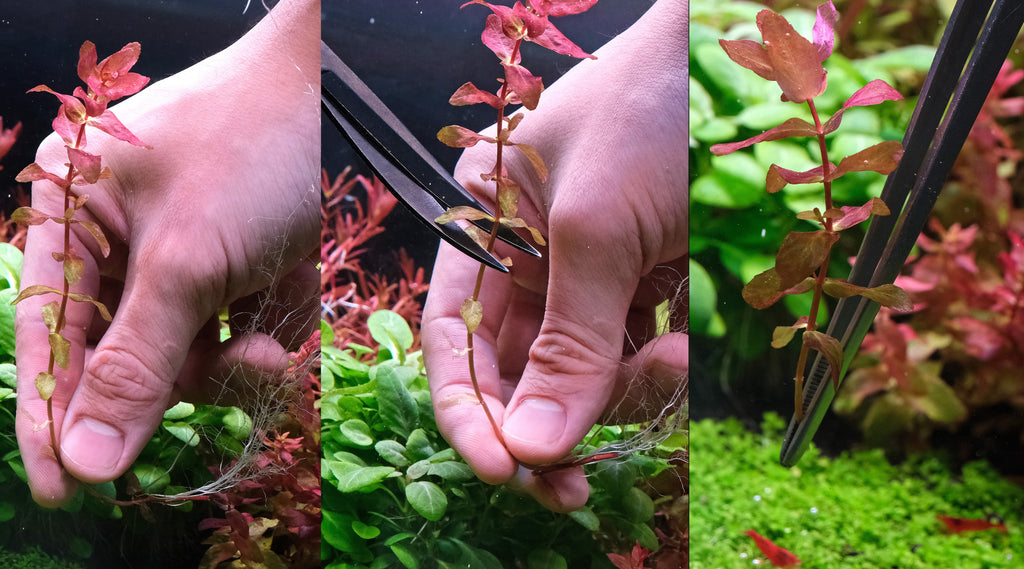
This replanting action does not have to be done every time we want to shorten taller stem plants. If the bottoms are relatively healthy, we can do a straight trim instead. This means just cutting off and discarding the tops, leaving the rooted portion to regrow. We do replanting more often when the plants are affected by algae, or have old growth that is badly deteriorated and attracting algae.
In this tank, the Lobelia cardinalis bush was just trimmed, and was not replanted. The other bushes were topped and replanted a couple of times to remove old growth and replace them with only the fresh top portion.
Timeline showing the impact of regular trimming, topping and replanting across a month
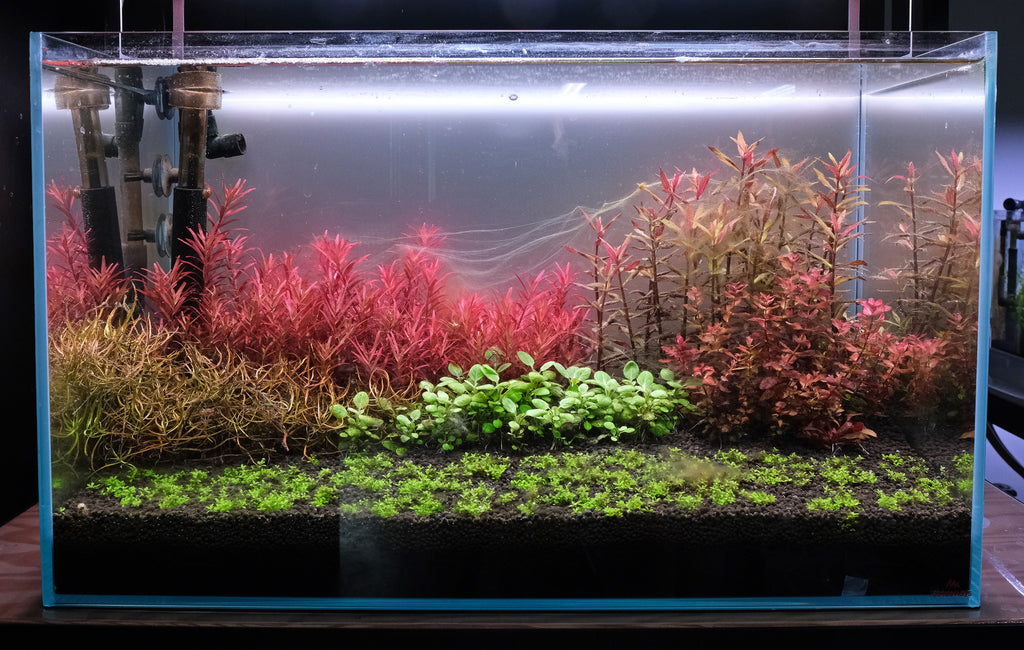
2nd Week – already new growth can be seen on most plants. However, there is a lot of poor quality older growth that needs to be cleared. Diatoms are persistent. No need to panic or do drastic measures though; experience builds trust that the tank will stabilize on its own as long as fresh plant mass is dominant. Diatoms build up is siphoned away during water change to prevent it from smothering the plants.

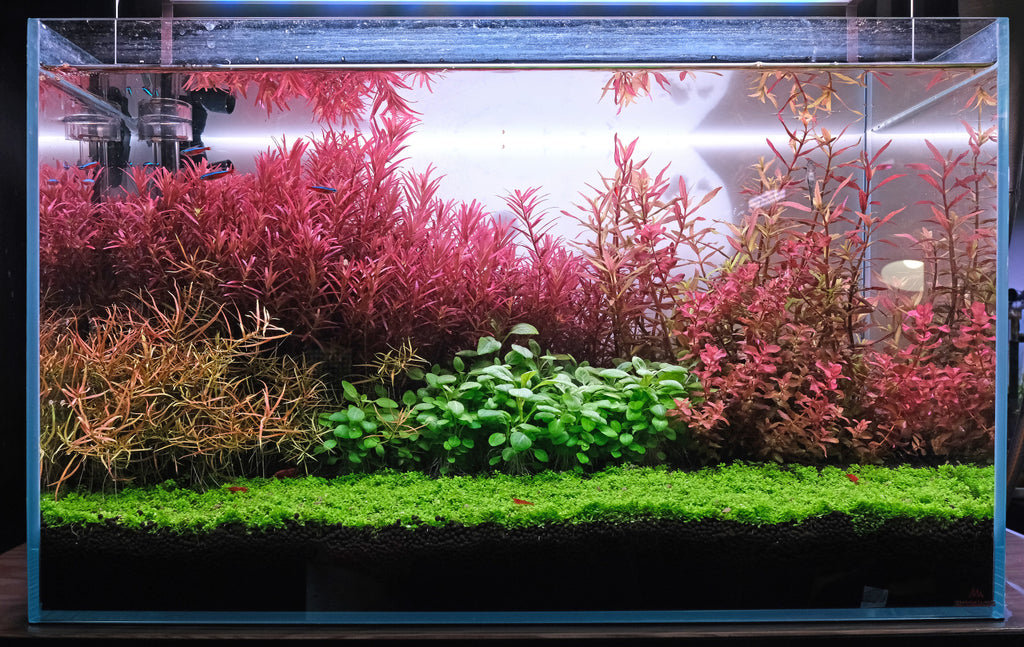
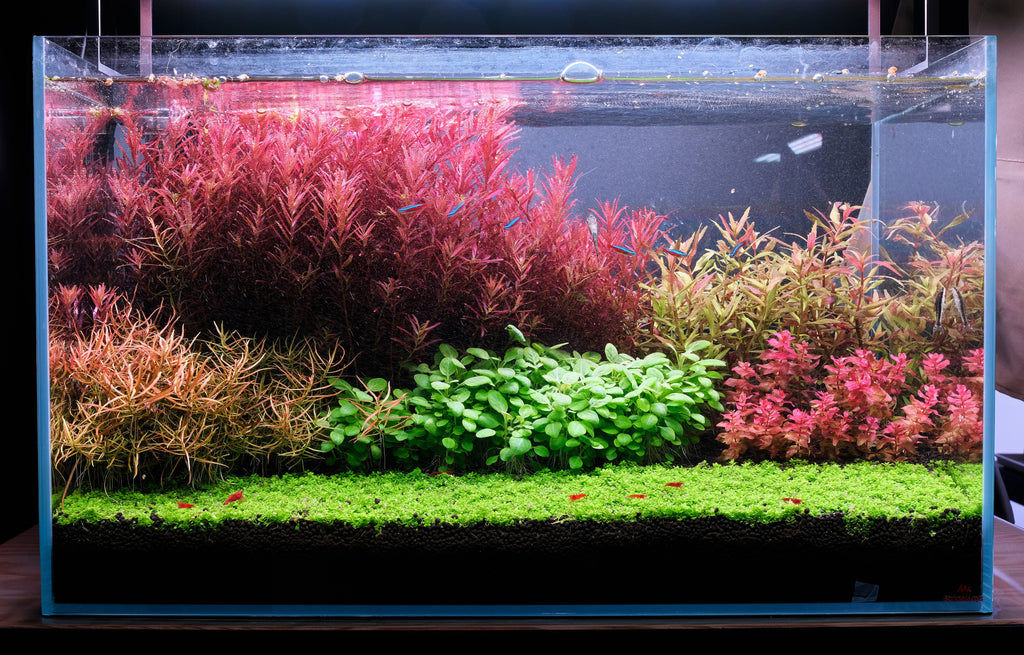
5th Week; As algae subsides, one can then shift focus onto shaping the bushes into desired shape. Light can be turned up at this point to induce deeper coloration, more livestock can be added to the tank. Topping and replanting is still done on the right side bushes to bring out better forms for those species.
Update:
These are a couple of pictures taken a few weeks later; the Rotala blood red bush has been trimmed, and the Ludwigia arcuata bush was replanted. As long as the plants (including the HC carpet) are rejuvenated over time, the tank can be kept in good form. Someone seeing the tank as it is today, will never imagine the algae cycle that it went through at the beginning stages:
Conclusions
The continuous action of removing older leaves/growth that attract algae, leaving algae resistant new leaves is what transforms the tank from an algae-infested mess into a relatively clean and fresh looking setup within a month without algicide usage. This concept is most applicable to new aquarium setups where plants go through a significant period of transition stress. However, it applies across all planted aquariums as a general approach. Old growth needs to be periodically removed and refreshed with new growth.
An aquarium with a dominant amount of fresh, robust, algae resistant leaves is the best protection against algae issues. Plant husbandry makes a greater impact on algae than parameters and most aquarists are overly focused on tweaking parameters when thinking about algae issues. Parameters are important where plant growth is concerned, however, tweaking parameters alone seldom resolves issues associated with plant husbandry.
For tanks with slower growth rates – plants take longer to produce adapted leaves and fresh new growth. This means that refreshing the tank with new growth can take quite some time. This is most apparent in non CO2 injected tanks where growth rates are slow. Thus this method alone will take time to produce results in such tanks.
For tanks with fast growth rates, such as CO2 injected high light tanks with high nutrient levels – this method is very quick to produce results as there is a lot of fresh new growth being produced. However, hobbyists running such tanks can find it tedious to keep up with the trimming and replanting work. Fast growth also means the tank gets overcrowded faster – the new growth of today becomes the old growth of tomorrow and the cycle repeats infinitely.
In the long run hobbyists should choose to set growth rates at a pace that they can manage. If you do not have time to do trimming and replanting work; choose to slow down the pace of growth parameters or choose slower growing species.

